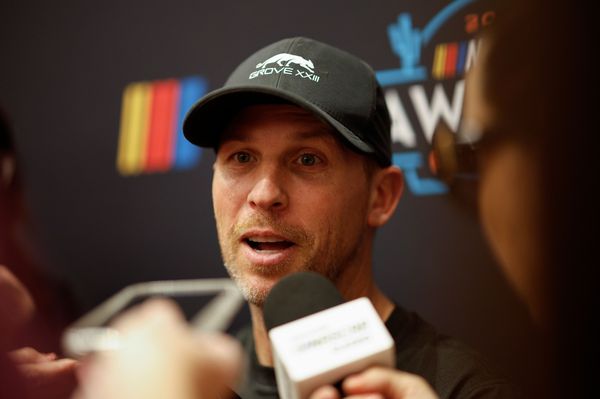
With four LMDh prototypes on the grid, Cadillac will be the most represented manufacturer in the Hypercar class at the 2025 24 Hours of Le Mans. Porsche also has four 963s entered, but one of them is fielded by the customer team Proton, while the American force is operating as a unified front at the legendary French race. In La Sarthe, the two Cadillac V-Series.Rs run in the WEC by Jota will be joined by the IMSA outfits of Whelen and Wayne Taylor Racing, with a full and open data-sharing policy between them.
On paper, it sounds like a perfect scenario, especially since the General Motors prototype already has two years of experience at Le Mans to draw from. But the scale of the project hides a few traps, starting with a rather paradoxical one: the risk of information overload.
“There’s a shared platform, so we can see everyone’s setup and we share data,” explains Sebastien Bourdais, who partners Earl Bamber and Jenson Button in the No. 38. “There’s a genuine joint effort in the project, which is interesting.
“But sometimes it makes the system a bit heavier too, because it opens up a lot of possibilities, and you don’t always have time to explore them all. You need to filter, to prioritise, and in some cases, not knowing might even help a bit. When you have doubts and too many possible directions, it can be a little destabilising.
“The first few months were a bit tricky, because we had one team that had worked with a Porsche before, another with Acura, and us with our own knowledge of the Cadillac. We had to merge all that into a common system. Things have come a long way since then. I think in the long term it will benefit the programme as a whole, but yes, the early stages were definitely a bit more complicated.”

In 2023 and 2024, Ganassi ran most of Cadillac’s programme, especially in the WEC. When that partnership ended and a new one began with Jota, it required a huge amount of work. The British outfit had previously run a customer Porsche 963 programme, which had to be put aside in order to get to grips with the V-Series.R, while the team also worked to raise its game to factory-team standards.
“It’s a partnership that looks great on paper, but we have to be realistic about where we’re at: we’re still a young team, that’s the truth,” Norman Nato tells Motorsport.com. He shares the No. 12 with Will Stevens and Alex Lynn.
“We’ve seen since the start of the year that we’re not yet at 100%,” Nato adds. “We’ve tried to learn race by race, so we can be as well-prepared as possible for the 24 Hours of Le Mans. We’re not the favourites, but we’re in the mix of cars that have something to fight for, so we’ll try to seize our chance.
“You don’t build a team in four or five months. You have to let time do its thing. We’re coming to Le Mans trying to win it, but this is a long-term project. I think we have a shot at the 24 Hours, but if it doesn’t work out, we’ll take the experience. It’s still a bit of a transition year, to prepare for the future, but we’ll give it everything, because in motorsport, there are no absolutes.”
Appearances Can Be Deceiving

With the exception of the new colours, nothing seems to have changed on the Cadillac V-Series.R, at least visually. And yet, getting back behind the wheel required a lot of relearning.
That’s because a technical joker was used on the electrical side of things, on a machine that, despite using the standard hybrid system shared by all LMDh cars, still has plenty of secrets left to reveal. This quickly became apparent in the early stages of the new partnership with Jota.
“There are different approaches to a common tool like the hybrid system,” confirms Bourdais. “It’s the same for everyone, but each team has gone about it in different ways and used it differently. That opened up a lot of discussion.
“On top of that, the evolution made to the car involved the systems, the entire wiring harness was redone, which gave us a bit more flexibility. Having more options, more data, and more baseline directions meant there was a lot of head-scratching in the engineers’ offices. It was a bit of a puzzle.

“Mechanically, the car hasn’t changed, so it’s purely about the systems around things like brake maps, the differential, and so on. That has a big impact on how the car behaves, and there are tons of different ways to approach it. That’s what’s funny, everyone started with more or less the same tool and developed it in their own way. We’re all rediscovering the car little by little, not necessarily because it has more potential, but because it feels so different.”
To illustrate just how much habits have been shaken up, the French driver doesn’t hesitate to share a few telling anecdotes.
“Sometimes you’re just not sure how the system works anymore, there are little things you remember that throw you off,” Bourdais explains.
“Like, reverse wasn’t in the same place anymore. All of a sudden, you’re stuck in a gravel trap, trying to engage reverse, and you can’t find it! That’s the case with a lot of systems, you’ve spent two years with one setup that maybe felt simpler, and suddenly it’s all different. So, you’re relearning a car you thought you knew pretty well.”
But at 46 years old, and gearing up for his 18th start at the 24 Hours of Le Mans, Bourdais remains optimistic, even if the complexity could once again delay Cadillac’s dreams of conquering a race the brand has never won.
“It’s a good thing because we have more tools and lots of things to optimize,” he concludes.
“But yeah, it’s a bit of a struggle at first to find your bearings.”







